“Cobra II” P-39 air racer – 1946 Thompson Trophy winner
"Cobra II” at the 1946 Thompson Trophy Race:
The P-39 known as “Cobra II,” was a Bell P-39Q-10BE, AAF 42-20869, assigned to the 430th Army Air Force Base Unit, Ephrata AAB, Washington, a Combat Crew Training Station, in April 1944, assigned to the 4th Air Force for fighter training. When training was shut down in February 1945, 42-20869 was transferred to the Reconstruction Finance Corporation, later the War Assets Administration, at Ponca City Air Field, Oklahoma, for storage and disposal.
Bell's swept wing L-39 project, based on the P-63, needed lighter 400 pound three blade props for the aircraft rather than the 460 pound four blade P-63 props. In 1946, buying a whole airplane was cheaper than just the prop. So Bell purchased two P-39Qs from the WAA for $750.00 each in February 1946. AAF 42-20733 became the ill-fated “Cobra I” and AAF 42-20869 became the famous “Cobra II.”
In the spring of 1946, it was announced the National Air Races would return to Cleveland, Ohio for the traditional Labor Day weekend event that hadn't been held since September, 1939. In addition to the Thompson Trophy, the race winner would receive $20,000 in prize money (about $262,968 in 2020 U.S. dollars). Additionally, there were $2,000 prizes for the leader of each lap. The Allegheny-Ludlum Trophy and $2,000 would go to the contestant who set a world record during the race. These were Serious Sums in 1946 and they bought out Serious Competitors.
It was obvious no one was going to be able to privately develop a race plane as had been done before the war. The field would be dominated by surplus fighters, available for as little as $500 in flyaway condition. Up at Buffalo, the two P-39s, minus the propellers Bell had bought them for, were sold to Skylanes Unlimited at a dollar each, for conversion to Cleveland racers. Three pilots were involved, Bell Chief Test Pilot Jack Woolams and Bell experimental test pilots Alvin “Tex” Johnston and Chalmers “Slick” Goodlin. The believed that the P-39, being lighter, was a better choice than the newer, but heavier P-63.
Bell Aircraft provided hangar space and assigned engineer Art Krege and five mechanics to the project.
All unneeded equipment was removed: armament, ammunition racks, 227 pounds of armor plate, radios, and the oxygen system. The self-sealing fuel tanks were replaced by lightweight Neoprene tanks that increased the fuel supply by 10 percent. Altogether each now weighed about 4,500 pounds, 1,000 pounds had been removed. The fabric covered control surfaces were reskinned with aluminum to avoid ballooning at high speeds. A 36-volt battery was installed to allow the landing gear to retract in five seconds. Twelve-stack exhausts were installed. The adjustable trim tabs were deleted. Gyroscopic instruments were removed. The pitot tube was moved from the left wing tip and placed on a long boom projecting through the propeller hub. The roll-down side windows were replaced by fixed Plexiglas panels.
The most important change was replacement of the P-39Q's 1,325 hp Allison V-1710-85. Engineers at Allison recommended that a modified Allison XV-1710-135 (E31) engine be used for the two racers. The modified engines used an increased-diameter supercharger impeller and undersized pistons to reduce cylinder wall friction. Using 140-octane Mobil aviation gasoline, they produced 2,000 horsepower at 3,200 r.p.m. with 86 inches of manifold pressure. The high power output required that the engine be provided with a continuous injection of a precisely-measured water and ethyl/methyl alcohol solution when operating above 57 inches of manifold pressure. An 85 gallon tank for the injection mixture was placed in the nose. It also needed a large oil cooling radiator, which was attached on the lower centerline between the main gear. The increased power of the XV-1710-135 required a four-blade propeller from the P-63 Kingcobra. This was an Aeroproducts A624S constant-speed propeller with hollow steel blades.
Flight tests showed 430 mph was possible. For the 1946 Thompson, Jack Woolams would fly the red and black “Cobra I” (NX92847), while Johnston flew the yellow and black “Cobra II” (NX92848).
Entrants for the 1946 race included many well-known air racers, test pilots and combat pilots: Cook Cleland, a U.S. Navy dive bomber pilot and test pilot; Woodrow W. (“Woody”) Edmondson, an aerobatic pilot; Howard Clifton (“Tick”) Lilly, test pilot for the National Advisory Committee for Aeronautics (NACA); Alvin Melvin (“Tex”) Johnston, test pilot with Bell Aircraft Corporation; Anthony W. (“Tony”) LeVier, Chief Engineering Test Pilot for Lockheed Aircraft Corporation, and an experienced pylon racer (second place winner in the 1939 Thompson race, the last of the re-war events); Earl Hill Ortman, test pilot for Douglas Aircraft Company, and also an experienced pre-war Thompson racer; Howard L. Pemberton; Bruce Raymond; Robert Swanson; Charles (“Chuck”) Tucker, ex-“Flying Tiger” in China, and a USAAF test pilot; George S. Welch, the Air Corps hero of Pearl Harbor, and test pilot for North American Aviation, Inc.; and Sylvester Joseph (“Steve”) Wittman, aircraft designer and air racer.
When race qualifications were held, Tex Johnston was placed first with his yellow Cobra II. His average speed was 409.091 mph. George Welch was second with his P-51D, number 37. Jack Woolams and Cobra I were third at 392.71 mph.
Jack Woolams was killed on August 30, two days before the race, when “Cobra I” crashed into Lake Ontario while returning to the Bell plant for an engine change.
The Thompson Trophy Race had always been one of the most popular events in air racing since it was flown in view of the crowd. Sponsored by Thompson Products Company (the predecessor of TRW), it was a ten-lap pylon race flown at low altitude around a 30-mile course. With the advent of the jet revolution, two divisions were established. The R Division for reciprocating engines, and the J Division was for jet-powered airplanes. While the R division was entirely civilian aircraft, the J division featured P-80s from the USAAF - among the Air Force "racers" was World War II ace Major Robin Olds, who would take second place in the staged "race." The race course was laid out as a parallelogram, with two 10-mile sides, and two 5-mile sides. There were two 75-degree turns and two 105-degree turns. Of the twelve airplanes competing in the 1946 Thompson Race, there was one P-39Q Airacobra; four P-63 Kingcobras; one FG-1D Corsair; a P-38L Lightning; and five P-51D Mustangs.
The Thompson Trophy Race was held Sunday, September 1, 1946. Tex Johnston took off and climbed to 300 feet. As he approached the first turn, he rolled “Cobra II” into a 4G turn at a75.5-degree angle of bank, and dove to 60 feet. Coming out of the turn, he was already far ahead of the others. George Welch dropped out when his engine overheated. Tony LeVier's P-38 held on to second place. By the ninth lap, Johnston was lapping the racers at the back of the field.
On the final turn, Johnston rolled into a 90-degree bank and passed inside a P-63 at an altitude of only 50 feet, flying at 430 mph to win the race. His average speed for the ten laps was 373.908 mph. Tony LeVier was second at 370.193 mph. Third, fourth and fifth were P-51Ds. Sixth was the FG-1D, with the third P-51 coming in seventh place. The last three were the P-63s.
Johnston won the $20,000 first place prize as well as the ten $2,000 lap prizes and the $2,000 speed record prize. He walked away with what would be today around half a million dollars.
In the 1947 race, “Cobra II” placed third behind two F2G Super Corsairs flown by Cook Cleland and Dick Becker, flown by Bell test pilot Gerald A. “Jay” Demming. Carrying race number 11, his average speed was 367.625 mph.
In 1948, Charles Brown, an Allison Engines test pilot, flew “Cobra II.” Sponsored by Stewart Motor Sales, a Kaiser-Frazier dealer, it was called the “KR-1” and was flown at 438 mph on a test flight. The race was 20 laps of a shorter, 15 mile course. Burning a special high octane fuel and turning a three blade prop, Brown qualified at 418.3 mph, just ahead of Cook Cleland's XF2G-1 at 417.424 mph. Both Cook Cleland and Dick Becker's F2Gs left the race early after backfires blew off their cowlings. Brown's top lap speed was 413 mph. Well ahead in the race, the Allison suffered a vapor lock on lap 19 and he was forced to land. Anson Johnson hung on to win at 383.77 mph in a P-51D.
Damaged in November 1948 while being ferried to Indianapolis, NX92848's racing days were over. It sat derelict until 1960 when Ed Maloney bought it. Maloney sold it to Michael D. Carroll, owner of Signal Trucking Co., in 1967. Now registered N9824, Carroll decided to go for the world piston engine speed record.
He had a highly modified V-1710 capable of 2,850 hp installed, clipped the wings, cleaned up the airframe, and changed the three blade prop back to a four blade prop. On August 10, 1968, Carroll took off from Long Beach Airport on the airplane's first test flight, enroute to Orange County Airport. At 11:15 a.m., the racer crashed at the Seal Beach Naval Weapons Station. Carroll bailed out, but his parachute did not open and he was killed. There was no post-crash fire because he had run out of fuel, proving once again that, when it comes to old airplanes, many pilots prove the fact there is no connection between the brain and the bank account.
Tex Johnston moved on to Boeing, where he tested the XB-47 Stratojet and flew the first flights of the YB-52 and XB-52 Stratofortress, and the Model 367-80 “Dash 80,”which he notoriously barrel-rolled over Lake Washington, on August 6, 1955. He also flew the first 707 airliner and the first KC-135A Stratotanker.
In November, 1955, Tex Johnston and his Boeing crew took the Model 367-80 to Stapleton Field at Denver, Colorado, to demonstrate it to United Air Lines at their headquarters. While there, he discovered two 11 year old boys trying to see the airplane, which was hangared due to poor weather, though the tail stuck out since the airplane was far too big to fit in the older hangar. When he asked the boys what they were doing peeking through the closed hangar door, they told him they had come to see the airplane. He replied, “Well, you can't see it from here, can you?” and took the boys inside, where he gave a tour of the airplane, even allowing them to sit in the pilot's seats. When lunch arrived, they were invited to share submarine sandwiches with the crew. With the tour over, it was time to leave, since they had to take four buses to get across Denver back home. When told that, he said, “We can't have that,” and drove the boys home himself.
That evening, having told my father about the adventure my best friend Richard and I had had on the “day off” he'd gotten us from school, I sadly recounted that I never got the name of our host. A little while later we were watching the evening news when they did a feature about the airplane, with the TV reporter talking to my host! “That's him!” To which my aviation-fan father gave me a long look and said, “You met Tex Johnston?” He then told me just who it was I had met.
Tex was the first famous pilot I ever met in a lifetime's career of meeting and talking with famous pilots, and I never exchanged names with him (but I learned to do so for all the rest). He was inducted into the National Aviation Hall of Fame in 1993, five years before his death at 84 (an interesting connection to his racing number).
THE KIT
Hasegawa's released their P-39Q as a limited-edition of “Cobra I” and “Cobra II” in 2012. The kit included decals for all the markings and trim in black, as well as a small fret of injection plastic with the ventral oil cooler the airplanes were modified with, a 4-blade spinner, plugs for the leading edge of the wings to replace the outboard machine guns, and a white metal 4-blade prop and the extended pitot tube. Everything else is the excellent P-39D-Q molding.
The kit was never re-released and today commands prices of more than $100 on eBay. Thus, when I walked into the LHS the first day it was open after the coronavirus shut down here and saw the kit on the shelf where the “modeler's estate sales” kits are, for only $29.95 - the original price! - it soon went out the door in my hands, since I had always regretted missing it the first time around.
CONSTRUCTION
The kit is extremely well-designed and really does “fall together.” After the detail parts are pre-painted, the entire assembly can be accomplished in a matter of a few hours, and no problems are presented as regards fit.
I pre-painted the detail parts, these being the cockpit, gear wells, landing gear and gear doors, which are all done in “Bell Green.” Having seen the very accurate P-39 restoration at Yanks Air Museum in Chino, I can assure you that this color is US Medium Green - nothing special or out of the ordinary, other than it being a different color from interior green which was used by most other manufacturers. You can use any available Medium Green you want for this. In my case, I used Tamiya XF-5 “Flat Green.”
When all this was dry, I applied the very nice instrument panel decals to their parts, using only the upper section of instruments, since the rest of the panel instruments were removed on the racers. While that was setting up, I assembled the cockpit and used Eduard seat belts.
I filled in the blast tubes for the guns in the upper nose panel and sanded that smooth. I put six fish weights in the nose, just in case that metal prop wasn't enough weight. I assembled the wing with no problems, and then attached it to the fuselage. The only place I used any Mr. Surfacer was on the fuselage to be sure I got rid of the centerline seam.
COLORS & MARKINGS
Since all the painted trim was supplied as decals, I only had to paint the model yellow. Looking at a color photo, it seems to be an intense shade of yellow, something like “canary yellow.” After prepping the model with a base of gloss white, I airbrushed a mixture of Tamiya X-2 Lemon Yellow, intensified with some Tamiya X-24 Clear yellow.
The black decals for the control surfaces and nose trim went on without problem. I then applied the markings, which also went on without problem under a coat of Solvaset.
I gave the model an overall coat of clear gloss, then unmasked the canopy. I attached the landing gear, prop and cockpit doors in the open position.
CONCLUSIONS
Way back in the early Jurassic, I got the Revell 1/46 P-39 “Cobra II” and did it to the best of my then not-so-great ability, but it was one of my favorite models. (It's being re-released by Atlantis this summer) The first time I went to the Reno Air Races, I saw Mira Slovak's P-39Q “Mr. Mennen,” and fell in love with P-39s as air racers. I did the Accurate Miniatures “Cobra II” release of the Eduard P-39, but most of the extra parts weren't included, plus the P-39Q 4-blade prop wasn't correct. So finding this, the best kit of this famous racer, was a real treat. The only thing the kit doesn't include is the reinforcing straps put on it after Woolam's crash of “Cobra I.”
Now I have the most famous airplane flown by the first famous pilot I ever met.
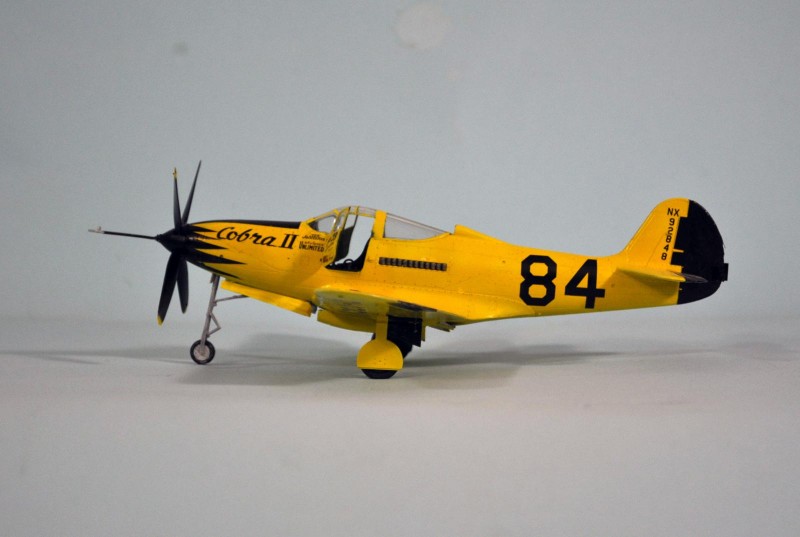
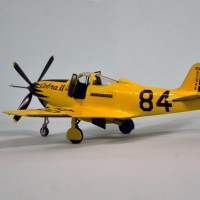
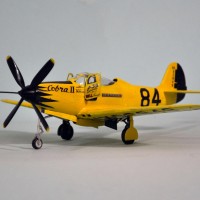

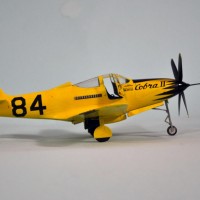
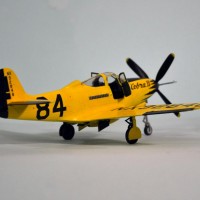
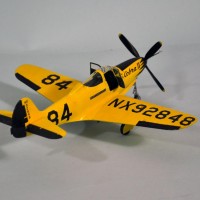
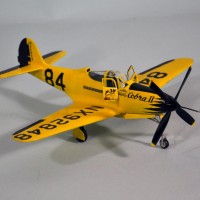
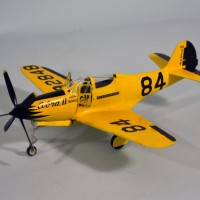
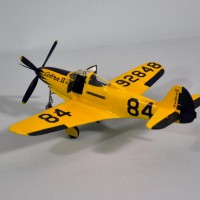
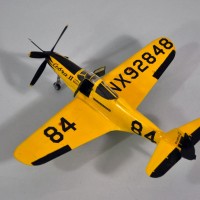
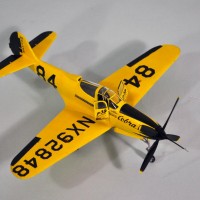
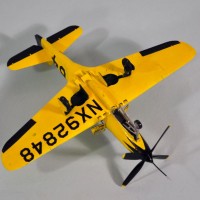
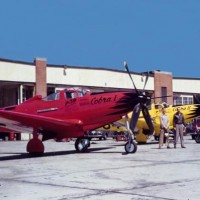
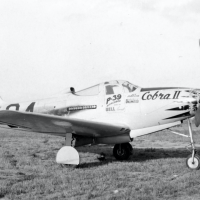
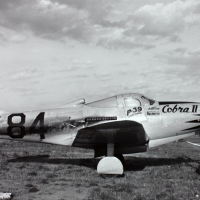
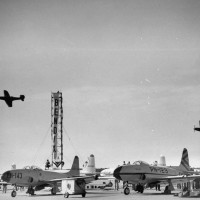
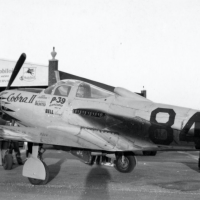
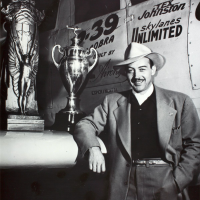
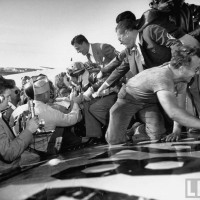
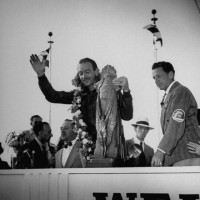
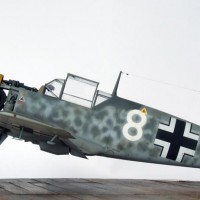
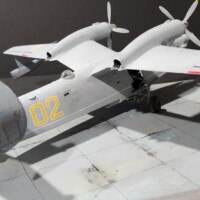
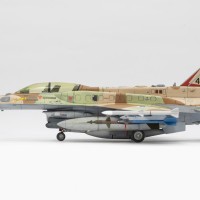
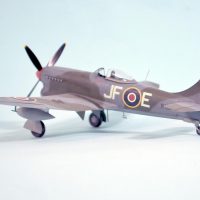
Great story and build Tom!
Nice clean racer, Tom. Well done.
That's a stunner of an Airacobra Tom. The yellow looks great, and the history write up was insightful and an enjoyable read.
Yay Cobra's here. Lookin' really good, neat and sweet. Just such a damn fine looking airplane. The Cobra was always a fast bird, the prototype did 390 mph I believe. Then the Air Corps wrecked it. The racers got it's true potential to show.
I have that old Revell P-39 somewhere too, with it's stand for desk or wall display. Not a bad kit for it's vintage.
Great looking Airacobra. TY for posting the pictures.
In the background story you mentioned another racer named George Welch. Is that the same George Welch that flew a P-40 during the Pearl Harbor attack, then later P-39's and P-38's?
Ummm... yes.
"... George S. Welch, the Air Corps hero of Pearl Harbor, and test pilot for North American Aviation..."
Sorry - My bad. Never knew he raced!
Great historical background, including the actual photos, and equally great model, Tom.
This kit was not meant to stay in the box for long
It really is a beautiful livery Tom, though Cobra I is also quite a beauty.
Been waiting to see this build and I'm not disappointed. Really enjoyed the history and photos as well.
Hello Tom,
Great story and a beautiful canary yellow bird.
Thanks for putting so much effort in this article.
Regards, Dirk
Impressive story and an ever more impressive build.
Thanks for sharing all this information and your beautiful build.
Yet another great build accompanied by great history, Tom.
My compliments Tom on a fine model and a great story...very well done.
Beautiful job, Tom. I REALLY loved the write-up about the "two kids". That's how it began for a lot of us...just loving airplanes. When I was stationed at Davis-Monthan AFB in Tucson in the early 80's, I would drive by a section of the "Boneyard" every day going to work and coming home. 367-80 sat there proudly by the back gate.
Amazing job and great story, you always seem to be in the right place at the right time. Air racers have a lot in common with car models, and it's hard to get the finish right. The paint and decals look fantastic.
A fascinating story and intriguing historical background- and your model lives up to this gripping story. Congratulations, well done!
Nice one, Tom!
Super story, period photos, paint job and build! Another “winner”!
Tom, This has to be one of my favorite paint schemes, and for some reason has escaped my work table. I also really enjoyed the story. I love racing, however am a little torn between watching them race, and risk being destroyed or preserved in a museum. An occasional fly by is nice, but I cant stand the thought of loosing any more of these treasures.
Well done !
Me and PoF have parted ways over their stupidity with the N9M, the only one of the original flying wings in the world. They knew from the get-go those Franklin engines were bad and let some f o o l loose in it. Them and Collings with the B-17 fiasco.
Just had the pleasure of reading this while drinking a cold one. All I can say is “thank you” and what a beauty of a build.